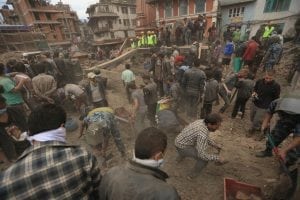Latest News
[Via Satellite 04-28-2015] Following the 7.8 magnitude earthquake that struck the nation of Nepal on April 25, satellite companies and organizations have stepped in to provide emergency telecommunications services. As of April 27, the United Nations (UN) reported more than 3,000 deaths and thousands more injuries. The Nepal government’s National Emergency Operation Centre (NEOC) described the disaster as the worst earthquake to hit the area in the past 80 years, and aftershocks continue to complicate rescue efforts.
In response to this tragic event, the International Telecommunications Union (ITU) has deployed 35 satellite mobile phones and 10 satellite Broadband Global Area Network (BGAN) terminals as well as laptops and solar panels. The supplies are expected to aid in restoring critical communications and coordinating relief efforts where terrestrial telecommunications infrastructure has been compromised or destroyed.
“Emergency telecommunications play a critical role in the immediate aftermath of disasters,” said Brahima Sanou, director of the ITU’s Telecommunication Development Bureau, said in a statement. “They ensure timely flow of information that is much needed by government agencies and other humanitarian actors involved in rescue operations.”
Satellite operator Spacecom has focused additional capacity from its newest satellite, Amos 4, to support volunteers in Nepal and the adjacent regions. Launched in 2013, the satellite carries eight Ku-band transponders of 108 MHz and four high-power Ka-band transponders of 216MHz, each with steerable beams from the 65 degrees east orbital location. The company said it is offering capacity free of charge to emergency responders, and is also ramping up capacity for Satellite Newsgathering (SNG) teams in the region.
“Our satellite services are ready to assist the country, its businesses, international aid groups, emergency responders and news gathering operators to rapidly and easily renew their operations and communications needs,” Eyal Copitt, senior vice president of sales for Asia, Africa and marketing at Spacecom, said in a statement.
Satellite and telecommunications relief organizations are also responding. Télécoms Sans Frontières (TSF), a relief organization supported by Inmarsat, has deployed a team from both its international headquarters and its Regional Office for Asia and Pacific (ROAP). The Nongovernmental Organization (NGO) is supplying IsatPhone Pro satellite voice calls and BGAN terminals for satellite communications to emergency responders and populations impacted by the earthquake. TSF has access to free airtime and financial aid resources to re-establish communications following disasters such as this. Luxembourg-based emergency.lu is also sending personnel, with satellite support available from SES to aid in relief efforts. Thuraya as well is providing satellite communications to coordinate relief efforts with the Abu Dhabi Search and Rescue Department.
Additional TSF teams from the Regional Office for the Americas and the Caribbean (ROAC) in Washington and Vanuatu remain on standby to assist. The UN Office for the Coordination of Humanitarian Affairs (OCHA) reported April 27 that the earthquake affected 30 out of 75 districts, including Kathmandu Valley. The earthquake has affected a wide range of geographies, ranging from rural, hilly regions to densely populated cities.
TSF reports that improvised tent cities have been set up within Nepal’s capital city Kathmandu, where locals and tourists have taken refuge. The NGO and many other telecom organizations and satellite companies, such as BT, Intelsat, ITC Global and SES, have been very recently involved in aiding the Pacific island nation of Vanuatu following the impact of Cyclone Pam in March this year.
Other companies and humanitarian organizations are involved in the earthquake response in Nepal as well. Facebook has donated a minimum of $1 million in cash, technology and services, including support for IT connectivity specialist NGO NetHope. The UN is supplying other resources, such as 11,000 plastic sheets and 4,000 solar lanterns to hilly districts of Ramechhap, Okhaldhunga and Sindhuli in the East part of the country. The agency announced a follow-on shipment of 8,000 plastic sheets and 4,000 solar lamps being flown in by a cargo plane from Dubai to the Nepalese capital.
A large number of satellite imagery companies and agencies, such as DigitalGlobe, the German space agency (DLR) and Italy’s COSMO-SkyMed program, are also involved in aiding the relief effort. As first responders continue to make headway, satellite will play a vital role in restoring the affected areas.
The United States Geological Survey (USGS) has registered 40 aftershocks above a magnitude 4.5 within Nepal’s borders, of which 16 measured at magnitudes of 5.0 or higher at the time of publication.
Get the latest Via Satellite news!
Subscribe Now